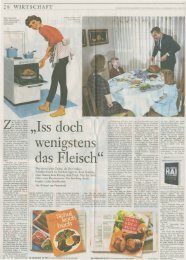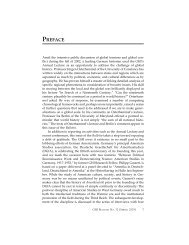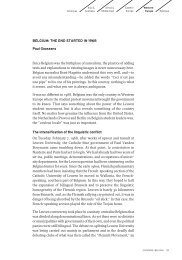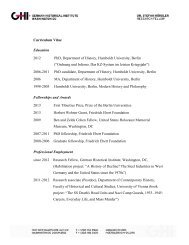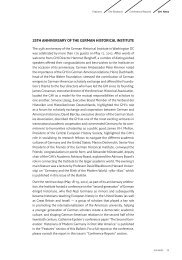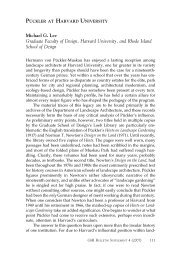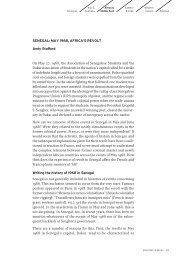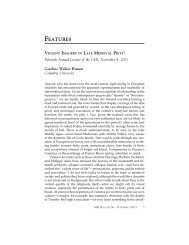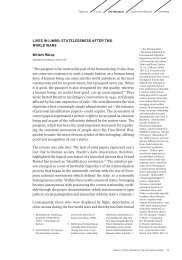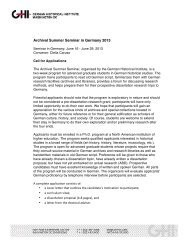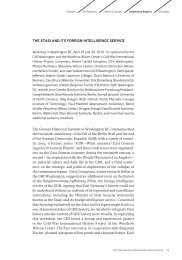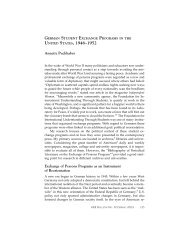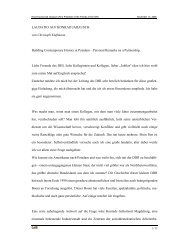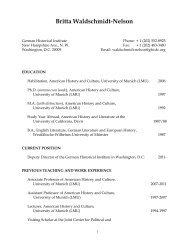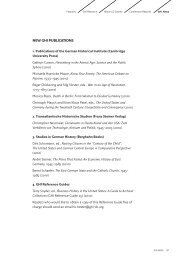THE GLOBAL BUSINESS WITH LOCAL MUSIC: WESTERN ...
THE GLOBAL BUSINESS WITH LOCAL MUSIC: WESTERN ...
THE GLOBAL BUSINESS WITH LOCAL MUSIC: WESTERN ...
Create successful ePaper yourself
Turn your PDF publications into a flip-book with our unique Google optimized e-Paper software.
Features GHI Research Conference Reports GHI News<br />
<strong>THE</strong> <strong>GLOBAL</strong> <strong>BUSINESS</strong> <strong>WITH</strong> <strong>LOCAL</strong> <strong>MUSIC</strong>: <strong>WESTERN</strong><br />
GRAMOPHONE COMPANIES IN INDIA BEFORE WORLD WAR I<br />
Christina Lubinski<br />
GHI WASHINGTON<br />
The period from Western industrialization to World War I has<br />
aptly been described as that of the “first global economy” because<br />
international trade expanded rapidly during that time. 1 While there<br />
is a lot of uncertainty about the amount and composition of foreign<br />
investments, scholars agree that the share of trade in world output<br />
rose steadily until 1913. According to an estimate by John Dunning,<br />
about one-third of total world foreign investment took the form of<br />
direct foreign investments in 1913, because multinational companies<br />
not only exported to foreign countries but also owned assets and<br />
exerted management control there. 2 Setting this number in relation<br />
to world output suggests a level of economic integration that was not<br />
reached again until the 1990s. 3<br />
Different factors added to this development. Newly available<br />
technologies in transport and communication, such as railroads,<br />
steamships and the telegraph, facilitated international travel, communication,<br />
and commerce, while the gold standard laid the basis<br />
for cross-border capital flows. The adoption of free trade and the<br />
expansion of Western imperialism led to more exchanges between<br />
imperialist countries and their colonies, which were opened up,<br />
often forcefully, to international trade. 4 As a consequence, the share<br />
of British foreign investments going to Europe and the United States<br />
fell from 52 to 26 percent between 1870 and 1914, while the share<br />
going to the British Dominions and Latin America rose from 23 to<br />
55 percent. 5<br />
The gramophone industry was a part of this highly integrated world<br />
economy right from its inception. 6 Although most of the existing literature<br />
about this industry focuses on the United States and Western<br />
Europe, 7 some scholars have started exploring the early relationships<br />
1 Geoffrey Jones, Multinationals<br />
and Global Capitalism:<br />
From the Nineteenth<br />
to the Twenty-First Century<br />
(Oxford, New York,<br />
2005), 18-22.<br />
2 John H. Dunning, Multinational<br />
Enterprises and<br />
the Global Economy (Wokingham,<br />
Reading, Mass.,<br />
1992).<br />
3 For a more detailed critical<br />
review of the parallels<br />
between the decades before<br />
World War I and the<br />
last third of the twentieth<br />
century, see Paul Bairoch<br />
and Richard Kozul-Wright,<br />
“Globalization Myths:<br />
Some Historical Reflections<br />
on Integration, Industrialization<br />
and Growth<br />
in the World Economy,”<br />
UNCTAD Discussion<br />
Papers No. 113 (1996).<br />
4 Peter J. Cain and Anthony<br />
G. Hopkins, British Imperialism,<br />
1688-2000 (New<br />
York, 2001).<br />
5 George A. Kenwood and<br />
Alan L. Lougheed, The<br />
Growth of the International<br />
Economy, 1820-1990: An<br />
Introductory Text (London,<br />
New York, 1992), 30.<br />
6 Peter Martland, Since Records<br />
Began: EMI, the First<br />
100 Years (London, 1997);<br />
Pekka Gronow and Ilpo<br />
Saunio, An International<br />
History of the Recording Industry<br />
(London, New York,<br />
1998); Geoffrey Jones, “The<br />
Gramophone Company: An<br />
Anglo-American Multinational,<br />
1898-1931,” Business<br />
History Review 59, no.<br />
1 (1985): 76-100.<br />
7 David Suisman, Selling<br />
Sounds: The Commercial Revolution<br />
in American Music<br />
(Cambridge, Mass., 2009);<br />
A. J. Millard, America on<br />
Record : A History of Recorded<br />
Sound (Cambridge,<br />
New York, 1995); William<br />
Howland Kenney, Recorded<br />
Music in American Life: The<br />
Phonograph and Popular<br />
Memory, 1890-1945 (New<br />
York, 1999); Stefan Gauss,<br />
Nadel, Rille, Trichter: Kulturgeschichte<br />
des Phonographen<br />
und des Grammophons<br />
in Deutschland (1900-<br />
1940) (Cologne, 2009).<br />
LUBINSKI | <strong>THE</strong> <strong>GLOBAL</strong> <strong>BUSINESS</strong> <strong>WITH</strong> <strong>LOCAL</strong> <strong>MUSIC</strong> 67
8 Gerry Farrell, Indian Music<br />
and the West (Oxford, New<br />
York, 1997); Vibodh Parthasarathi,<br />
“The Scramble for<br />
Sound,” ArtConnect: The IFA<br />
Magazine 4, no. 1 (2010): 40-<br />
55; Michael S. Kinnear, The<br />
Gramophone Company’s First<br />
Indian Recordings, 1899-1908<br />
(Bombay, 1994). On China,<br />
see Andreas Steen, Zwischen<br />
Unterhaltung und Revolution:<br />
Grammophone, Schallplatten<br />
und die Anfänge der Musikindustrie<br />
in Shanghai, 1878-<br />
1937 (Wiesbaden, 2006).<br />
9 Mira Wilkins, The Emergence<br />
of Multinational Enterprise:<br />
American Business Abroad<br />
from the Colonial Era to<br />
1914 (Cambridge, MA, 1970);<br />
Geoffrey Jones, Merchants<br />
to Multinationals: British<br />
Trading Companies in the<br />
Nineteenth and Twentieth<br />
Centuries (Oxford, 2000);<br />
Geoffrey Jones, Multinational<br />
Strategies and Developing<br />
Countries in Historical<br />
Perspective, Harvard<br />
Business School Working<br />
Paper 10-076 (2010); John<br />
M. Stopford, “The Origins of<br />
British-based Multinational<br />
Manufacturing Enterprises,”<br />
Business History Review 48,<br />
no. 3 (1974): 303-35.<br />
10 John Hartley, Creative<br />
Industries (Malden,<br />
MA, 2005), 1.<br />
11 For examples and characteristics<br />
of creative industries,<br />
see the articles in the special<br />
issue of Business History<br />
Review 85, no. 2 (2011).<br />
Western gramophone companies entertained with Asia. 8 In this<br />
article, I will describe the pre-World War I business of Western<br />
gramophone firms in India. India held a particular fascination for<br />
these companies because it was one of the first Asian countries to be<br />
penetrated by the industry and one of the biggest markets in terms of<br />
the number of consumers. Moreover, the implementation of Anglo-<br />
Saxon property law in the British colony ensured a more or less open<br />
field for Western businesses that sought to import manufactured<br />
goods into the country. The commercial relations with Britain also<br />
made the country more accessible for other foreign companies, as<br />
they often turned to British agents for support and profited from<br />
their experiences.<br />
Despite this advantageous context, selling gramophones and<br />
records to Indian consumers was by no means an easy task. The<br />
gramophone and music business faced a series of challenges<br />
from transport and infrastructure to climate, communication, and<br />
the control of local agents. While those problems were typical<br />
for early multinationals in many industries, 9 the “creative” music<br />
industry faced some additional challenges. Creative industries<br />
are broadly defined as those producing goods and services<br />
associated with “cultural, artistic, or simply entertainment<br />
value.” 10 The gramophone industry simultaneously sold gramophones<br />
and music on records. As I will show, these two product<br />
lines were complementary and heavily dependent on one another.<br />
Music, as a creative product, has subjective qualities, and its consumption<br />
is taste-driven and culturally contingent. 11 This article<br />
will trace how Western manufacturers learned to be successful in<br />
India by adapting to the taste and preferences of their consumers<br />
on the ground. Exploring the commercial opportunities in a musical<br />
scene that they often did not understand or appreciate, Western<br />
gramophone companies found themselves forced to delve into Indian<br />
musical traditions. Moreover, the political developments at the<br />
turn of the twentieth century further reinforced this trend to give<br />
business a local orientation. The emerging nationalism in<br />
British India, particularly in the region of Bengal and its capital<br />
city Calcutta, led to a boycott of foreign products beginning<br />
in 1905, which affected the gramophone companies’ business<br />
firsthand. To respond to this challenge, Western manufacturers<br />
explored different strategies, to be discussed in this article, ultimately<br />
aiming at making their products and production processes<br />
more local.<br />
68 BULLETIN OF <strong>THE</strong> GHI | 51 | FALL 2012
Features GHI Research Conference Reports GHI News<br />
In the global economy before World War I, the gramophone companies<br />
experienced the typical tension between global ambitions and<br />
local markets. While accessing markets such as India opened up<br />
new opportunities, it was a challenge to understand local tastes and<br />
customs, in particular, in a creative industry like music. Local events,<br />
such as the rising popularity of the nationalist movement, changed<br />
musical tastes and consumers’ choices about whom to buy from. The<br />
challenge to sell products internationally while still responding to<br />
local demands is one that still very much occupies today’s creative<br />
industries: understanding how firms dealt with it during the first<br />
global economy may help to better contextualize and understand<br />
this challenge. The gramophone industry identified the global-local<br />
tension early on and applied different strategies to deal with it. While<br />
its managers worked assiduously to exploit ownership advantages<br />
and reach an ever-wider range of consumers, they also made their<br />
products more local and learned to adapt to the demands of the<br />
Indian market by trial and error.<br />
I. The Birth of the Gramophone Industry and Its<br />
International Business<br />
“[N]othing that can be conceived would be more likely to create the<br />
profoundest of sensations, to arouse the liveliest of human emotions,<br />
than once more to hear the familiar voices of the dead. Yet science<br />
now announces that this is possible, and can be done,” 12 reported<br />
Scientific American in November 1877. The device that made it possible<br />
to listen to dead people’s voices was the “talking machine,”<br />
invented by the American inventor Thomas Edison. Born on February<br />
11, 1847, in Milan, Ohio, Edison had experimented with the telegraph<br />
and the telephone during the 1870s and had invented a machine<br />
that would transcribe telegraphic messages through indentations on<br />
paper tape. After discussing different names and related utilizations<br />
for the machine — such as antiphone or back talker, chronophone or<br />
speaking clock, didaskophone or portable teacher, and glottophone<br />
or language speaker — Edison named the machine “phonograph.” 13<br />
He filed for a patent on December 24, 1877, which was issued two<br />
months later on February 19, 1878. 14<br />
The American public took great interest in the new technology. The<br />
invention was reported in several newspapers during the years 1877<br />
and 1878. “The telephone … is destined to be entirely eclipsed by the<br />
new invention of the phonograph. The former transmitted sound.<br />
12 Edward H. Johnson,<br />
“A Wonderful Invention:<br />
Speech Capable of<br />
Indefinite Repetition<br />
from Automatic<br />
Records,” Scientific<br />
American Nov. 17<br />
(1877): 304.<br />
13 The Thomas Edison<br />
Papers, Rutgers University,<br />
Document File<br />
Series — 1877: (D-77-02)<br />
Edison, T.A. —<br />
General [D7702ZEO;<br />
TAEM 14:242].<br />
14 United States Patent<br />
Office. T. A. Edison,<br />
Phonograph or Speaking<br />
Machine. No. 200,521.<br />
Patented February 19,<br />
1878. Available online:<br />
http://edison.rutgers.edu/<br />
patents/00200521.PDF<br />
(accessed May 22, 2012.)<br />
LUBINSKI | <strong>THE</strong> <strong>GLOBAL</strong> <strong>BUSINESS</strong> <strong>WITH</strong> <strong>LOCAL</strong> <strong>MUSIC</strong> 69
The latter bottles it up for future use,” 15 reported the New York Times<br />
on November 7, 1877. At the beginning of 1878, Edison sold the<br />
manufacturing and sales rights to a syndicate in return for $10,000<br />
in cash and a 20 percent royalty on any sales. 16 However, the invention<br />
initially appeared to be of little practical use. The machine was a<br />
laboratory curiosity but seemed unlikely to create a constant stream<br />
of income. Operating the early phonographs was complicated, and the<br />
recordings made on tin foil were usually ruined after a few uses. The<br />
newly founded Edison Speaking Phonograph Company, incorporated<br />
on April 24, 1878, sold no more than 2,000 phonographs over the<br />
following two years and ceased to exist in 1880. Edison turned his<br />
attention to other inventions, most importantly electric light, and set<br />
the phonograph aside.<br />
15 “The Phonograph,” New York<br />
Times, November 7, 1877, 4.<br />
16 Frank W. Hoffmann and<br />
Howard Ferstler, Encyclopedia<br />
of Recorded Sound (New York,<br />
NY, 2005), 360.<br />
17 Frank Caso, “Emile Berliner,”<br />
in Immigrant Entrepreneurship:<br />
The German-American<br />
Business Biography, 1720<br />
to the Present, vol. 2, ed.<br />
William J. Hausman<br />
(German Historical Institute.<br />
Last modified March 15,<br />
2012. http://www.immigrantentrepreneurship.<br />
org/entry.php?rec=34<br />
(accessed May 22, 2012).<br />
18 In the early years, “talking<br />
machine” was the neutral<br />
term while “gramophone”<br />
and “phonograph” refer red<br />
to machines by a specific<br />
manufacturer. Later on,<br />
“gramophone” replac ed<br />
“talking machine” as<br />
the generic term.<br />
It was not until a decade later that a German-born immigrant, Emile<br />
Berliner, first demonstrated his improved version of the talking machine,<br />
which etched the sound onto a flat metal disc rather than onto a<br />
cylinder. Emile Berliner had immigrated to the United States in 1870<br />
to pursue a job opportunity at a store in Washington DC. 17 While<br />
working as a clerk and traveling salesman, Berliner had become<br />
interested in the newly developed telephone and experimented with<br />
an improved transmitter, which he eventually patented in the United<br />
States. The American Bell Telephone Company bought the rights to<br />
this invention and hired Berliner as a research assistant. He stayed<br />
with the company in New York and Boston until 1884, working on<br />
a number of problems associated with the telephone. Berliner became<br />
an American citizen in 1881 and that same year married Cora<br />
Adler, who was also of German descent. In 1884 he gave up his job<br />
and moved to Washington DC to become a private researcher and<br />
inventor. From 1886 on, he devoted most of his work to the talking<br />
machine, inventing a machine with a turntable to play discs, which<br />
he called a “gramophone,” an inversion of Edison’s original name<br />
“phonograph.” 18 Despite Berliner’s improvement of the technology,<br />
the machine remained a curiosity. Because it was operated by hand,<br />
the user had to keep the turntable at a constant speed. This problem<br />
was eventually overcome when Eldridge R. Johnson, an engineer from<br />
New Jersey, developed a cheap spring motor that assured a constant<br />
speed of rotation.<br />
In 1887, Berliner patented his invention in Germany and England.<br />
Starting in 1889, he cooperated with the German toy manufacturer<br />
Kaemmer & Reinhardt in Wolfershausen, Thuringia, which<br />
started selling small discs and small hand-turned machines<br />
70 BULLETIN OF <strong>THE</strong> GHI | 51 | FALL 2012
Features GHI Research Conference Reports GHI News<br />
as children’s toys<br />
for a few years. 19<br />
In 1894, Berliner<br />
founded the United<br />
States Gramophone<br />
Company in Washington<br />
DC and in<br />
1896 licensed his<br />
pro duct to a group<br />
of businessmen<br />
who formed the<br />
Berliner Gramophone<br />
Company of<br />
Philadelphia. The<br />
consortium hired<br />
a manager, Frank<br />
Seaman, to organize<br />
the National Gramophone<br />
Company in New York as the sales agent for both the discs<br />
and the machines.<br />
In 1897, the National Gramophone Company sent a sales manager,<br />
William Barry Owen, to London to sell the company’s machines and<br />
exploit the British and European rights of Berliner’s patents. Owen<br />
convinced a British lawyer, Trevor Williams, to invest in the gramophone.<br />
In April 1898, Williams and Owen formed the Gramophone<br />
Company (which after the merger with a typewriter manufacturer in<br />
1900 was renamed Gramophone Typewriter Ltd., hereafter GTL) as<br />
a trading syndicate. In the same year, Emile Berliner and his brother<br />
Joseph set up a manufacturing plant for records in Hanover, Germany,<br />
to supply the European demand. 20<br />
Since the 1880s, Berliner’s business had expanded internationally.<br />
Besides the patents in Germany and England, Berliner obtained<br />
others in Italy, France, Belgium, and Austria. Berliner’s sons, Herbert<br />
and Edgar, opened a branch in Montreal, Canada, in 1899. But a series<br />
of copyright infringements and lawsuits led to the end of the Berliner<br />
business in the United States. In June 1900, a court injunction<br />
shut down the Berliner Gramophone Company of Philadelphia. For<br />
several years attempts were made to overturn the injunction but to<br />
no avail. Berliner passed his patent rights to Eldridge Johnson, who<br />
sold some of his patents to GTL and also supplied it with parts and<br />
components. In 1899, GTL (still called Gramophone Company until<br />
Emile Berliner, with<br />
the model of the first<br />
phonograph machine he<br />
invented. Source: Library<br />
of Congress, Prints and<br />
Photographs Division,<br />
Washington DC.<br />
19 Peter Tschmuck, Creativity<br />
and Innovation in the<br />
Music Industry (Berlin,<br />
Heidelberg, 2012), 19.<br />
20 Martland, Since Records<br />
Began.<br />
LUBINSKI | <strong>THE</strong> <strong>GLOBAL</strong> <strong>BUSINESS</strong> <strong>WITH</strong> <strong>LOCAL</strong> <strong>MUSIC</strong> 71
1900) bought the European and British Empire rights for the manufacture<br />
of sound recordings from Johnson, and in 1901 both agreed<br />
to a wide-ranging partnership in marketing, finance, and research.<br />
They also divided the world market between them: GTL was to sell<br />
in Europe, the British Empire, Russia, and Japan, while Johnson’s<br />
Victor Talking Machine Company (founded in 1901 in Camden, New<br />
Jersey) would sell everywhere else. 21<br />
21 Benjamin L. Aldridge,<br />
The Victor Talking Machine<br />
Company (n.d.).<br />
22 Martland, Since Records<br />
Began, 44.<br />
23 Peter Martland, “Gaisberg,<br />
Frederick William (1873–<br />
1951),” in Oxford Dictionary<br />
of National Biography<br />
(Oxford, 2004). http://www.<br />
oxforddnb.com (accessed<br />
July 30, 2012).<br />
24 Great Britain India Office,<br />
Statistical Abstract Relating to<br />
British India from 1892/3 to<br />
1901/02, Compiled From<br />
Official Records and Papers<br />
Presented to Parliament<br />
(London, 1903): 1.<br />
25 Siemens Archiv-Akte 35.<br />
Lk232, 306-11 Promemoria<br />
betreffend die directe indoeuropaeische<br />
Telegraphenlinie.<br />
Compare also Christina<br />
Lubinski, “Siemens’s<br />
Early Business in India: A<br />
Family Multinational’s Quest<br />
for Unity, 1847-1914,“ in<br />
Family Multinationals:<br />
Entrepreneurship, Governance,<br />
and Pathways to Internationalization,<br />
ed. Christina Lubinski,<br />
Jeffrey Fear, and Paloma<br />
Fernández Perez (New York,<br />
forthcoming).<br />
26 Department of Commerce,<br />
Bureau of Foreign and Domestic<br />
Commerce, Henry D. Baker,<br />
Special Consular Report No.<br />
72, British India with Notes on<br />
Ceylon, Afghanistan and Tibet<br />
(Washington, 1915): 9.<br />
Going global, however, proved to be more demanding than the<br />
gramophone companies initially expected. While the machines<br />
could be sold to other markets, it soon became obvious that a “onesize-fits-all”<br />
strategy would not be successful with regard to the<br />
recorded music. To broaden the portfolio and provide customers in<br />
foreign markets with suitable products, the gramophone companies<br />
started sending recording engineers to different parts of the world to<br />
record music. These young engineers, also known as “the experts”<br />
or, because of their young age, “the boys,” were regarded as an elite<br />
group and traveled around the world to spot new talent and expand<br />
the repertoire of the company. 22 In the late 1890s, American-born<br />
William Sinkler Darby, who had worked as an assistant in Emile<br />
Berliner’s laboratory in Washington, went on a trip to Russia on<br />
behalf of Berliner’s German company. In 1898, Fred Gaisberg, who<br />
had also previously worked for Berliner in Washington, became GTL’s<br />
first official recording engineer. He moved from the United States to<br />
London, where he was responsible for the first recording studio and<br />
several recording tours first in Europe and later worldwide. 23<br />
II. Into the Unknown:<br />
Western Gramophone Companies in India<br />
GTL and other gramophone companies showed a great interest in<br />
India as a market for their machines early on. Seen through the eyes<br />
of Western companies, the vast country with a population of 287<br />
million in 1901 24 was highly attractive, not only for the gramophone<br />
industry. The German electrical company Siemens, for example,<br />
sought to attract investors in its telegraph line from London to Calcutta<br />
by arguing in 1867 that India “with its enormous population<br />
and growing production” was not only one of the largest markets in<br />
the world but also a “gate for Europeans to the important markets of<br />
China, Japan, and Australia.” 25 Likewise, an American consular report<br />
of 1915 said that India, despite being under British control, was “one<br />
of the few large countries of the world where there is an ‘open door’<br />
for the trade of all countries.” 26<br />
72 BULLETIN OF <strong>THE</strong> GHI | 51 | FALL 2012
Features GHI Research Conference Reports GHI News<br />
Already before the turn of the century, English and Indian musical<br />
instrument dealers sold talking machines and music to the native<br />
and foreign populations in India. In Calcutta, English firms, such as<br />
T. E. Bevan and Co., Harold and Co., and the Western Trading Co.,<br />
and Indian firms, such as M. L. Shaw and Dwarkin & Son, advertised<br />
gramophones and recordings already before 1900. 27 Blank cylinders<br />
were particularly popular with the native population. Unlike discs<br />
that could only play back prerecorded voices, cylinders could be used<br />
for home recordings. They thus allowed for the recording of local<br />
music, whereas the gramophone firms sold almost exclusively Western<br />
recordings. At first, the gramophone was a novelty and several<br />
events were held to celebrate its arrival, including the “Phonograph<br />
Concert” at the Dalhousie Institute in Calcutta on November 16,<br />
1899. The Statesman, an Indian English-language broadsheet daily<br />
newspaper, announced that on this occasion “Edison’s Grand Concert<br />
Phonograph” would be played and that the event was open to the<br />
public for an admission fee. 28<br />
In July 1901, an agent of the Anglo-American GTL, John Watson<br />
Hawd, came to Calcutta to investigate business opportunities in<br />
India. He had been instructed by the London headquarters to take<br />
with him 500 talking machines and 30,000 records and to “prove<br />
the possibility of making a business there.” 29 Previously, GTL had<br />
worked with a British agent, the Mutoscope and Biograph Co. Ltd.,<br />
a company that had been active in India since 1898, but GTL had<br />
ended this partnership in early 1901. 30 In September of the same year,<br />
after traveling widely in India, Hawd recommended that a branch office<br />
be opened in Calcutta, which GTL did in November 1901. Hawd<br />
commented: “I think we shall do a fair business here if we only have<br />
the goods, but until we get native records we shall only be able to<br />
sell to Europeans and they are only 1 per 100 natives.” 31 Surprisingly,<br />
there was little debate about the prices for gramophones and records,<br />
which may suggest that customers, at least in the beginning, came<br />
from the highest social classes, which could afford these products.<br />
Even a small percentage of the overall population of India made for<br />
an interesting market for the Western firms, and the enormous size<br />
of the Indian market was frequently stressed. Hawd also repeatedly<br />
urged his supervisors to offer a more locally oriented product: “There<br />
will be a big business here … and it is best to own the territory, then<br />
we know it is well worked.” 32 He also commented on the challenges<br />
to be expected: “the country is so large that it will take a long time to<br />
cover it and as yet we have no dealers to speak of.” 33 The most urgent<br />
27 Kinnear, Indian<br />
Recordings, 9.<br />
28 Ranabir Ray Choudhury,<br />
Early Calcutta Advertisements,<br />
1875-1925<br />
[A Selection from the<br />
Statesman] (Bombay,<br />
1992), 16.<br />
29 EMI Music Archives<br />
(hereafter EMI), letter<br />
London to Hawd, January<br />
13, 1900.<br />
30 EMI, letter from Gram.<br />
Co to Hawd, Calcutta,<br />
August 23, 1901.<br />
31 EMI, letter Hawd to<br />
London, November 21,<br />
1901.<br />
32 EMI, letter Hawd, Calcutta<br />
to London, February<br />
13, 1902.<br />
33 EMI, letter Hawd,<br />
Calcutta to London,<br />
April 13, 1902.<br />
LUBINSKI | <strong>THE</strong> <strong>GLOBAL</strong> <strong>BUSINESS</strong> <strong>WITH</strong> <strong>LOCAL</strong> <strong>MUSIC</strong> 73
task for Hawd was the recording of native artists. “You must however<br />
send one man to make records,” he insisted again in October 1901. 34<br />
34 EMI, letter Hawd to<br />
London October 3, 1901.<br />
35 Frederick William<br />
Gaisberg, Music on Record<br />
(London, 1946), 52.<br />
36 See also Farrell, Indian<br />
Music, 114.<br />
37 Gaisberg, Music on Record. Gaisberg’s<br />
autobiography was first<br />
published in the US in 1942<br />
with the title The Music Goes<br />
Round (reprinted in 1977).<br />
This and following quotations<br />
are from the 1946 UK version,<br />
which is an identical reproduction<br />
of the US predecessor<br />
but includes more graphic<br />
materials.<br />
38 Ibid.<br />
39 Kinnear, Indian<br />
Recordings, 15-16.<br />
40 Farrell, Indian Music, 117;<br />
Jerrold Northrop Moore, A<br />
Voice in Time: The Gramophone<br />
of Fred Gaisberg, 1873-1951<br />
(London, 1976).<br />
41 Gaisberg, Music on<br />
Record, 54.<br />
Consequently, GTL prepared for its first recording expedition to<br />
the Far East, planning to record in Calcutta but also Singapore,<br />
Hong Kong, Shanghai, Tokyo, Bangkok, and Rangoon. The team<br />
of recording experts consisted of recording engineer Fred Gaisberg,<br />
his 19-year-old assistant George Dillnutt, and the businessman<br />
Thomas Dowe Addis, who was accompanied by his wife. According<br />
to Gaisberg, the aim of this trip was “to open up new markets,<br />
establish agencies, and acquire a catalogue of native records. … [A]s<br />
we steamed down the channel into the unknown I felt like Marco<br />
Polo starting out on his journeys.” 35 The terminology is revealing.<br />
Gaisberg’s likening himself to Marco Polo and the description of the<br />
trip as an “expedition” show that, although commercial concerns<br />
triggered the trip, Gaisberg and his colleagues saw themselves as<br />
brave explorers of an unknown world. 36 Gaisberg and his fellow<br />
travelers reached Calcutta in October 1902. 37 While unpacking, they<br />
were observed by the native population. “It was the first time the<br />
talking machine had come into their lives and they regarded it with<br />
awe and wonderment.” 38 Like other Western technologies exported<br />
to India, the gramophone gave the visitors power because they had<br />
the knowledge and means to control the machine.<br />
John Hawd awaited the crew in Calcutta. He arranged for a location<br />
for the recording sessions and got in touch with Amarendra<br />
Nath Dutt of the Classic Theatre and Jamshedi Framji Madan of the<br />
Corinthian Theatre, who established contacts to local artists. Dutt<br />
was known to be interested in the technology of sound recordings<br />
and had earlier purchased an Edison phonograph, which he used<br />
to record dialogues and songs of the plays being performed. Madan<br />
also took interest in the newly emerging sound and motion-picture<br />
technologies and owned a motion picture projector. The theaters<br />
were the main sources of entertainment for the general public at<br />
the time. 39<br />
According to Gaisberg’s diary, the first recordings made on November<br />
8, 1902, were of two nautch girls “with miserable voices.” 40<br />
Generally speaking, Gaisberg and the local agents of GTL found it<br />
hard to develop an understanding of the native music. As Gaisberg<br />
observed, “We entered a new world of musical and artistic values. …<br />
[T]he very foundations of my musical training were undermined.” 41<br />
However, according to Gaisberg, the British staff of GTL’s local office<br />
74 BULLETIN OF <strong>THE</strong> GHI | 51 | FALL 2012
Features GHI Research Conference Reports GHI News<br />
had even less understanding for the music: “I soon discovered that<br />
the English, whom we contacted and who were acting as our agents<br />
and factors, might be living on another planet for all the interest<br />
they took in Indian music.” 42<br />
During the following days, Gaisberg recorded the renowned female<br />
singer Gauhar Jan, who at the time was a local celebrity in<br />
Calcutta. Gaisberg met her during a visit to a wealthy babu, an<br />
Indian clerk: “We elbowed our way through an unsavory alley<br />
jostled by fakirs and unwholesome sacred cows, to a pretentious<br />
entrance … no native women were present excepting the Nautch<br />
girls, who had lost caste.” 43 Public performance by women was<br />
considered a low-status and often disreputable profession. The<br />
nautch girls performed music and dance in front of their audience<br />
accompanied by male musicians, who also acted as their teachers.<br />
When Fred Gaisberg first encountered the Indian nautch girls, he<br />
noted that all female singers were “from the caste of the public<br />
women, and in those days it was practically impossible to record<br />
the voice of a respectable woman.” 44 However, the translation<br />
“dancing girl,” which was often used in contemporary sources,<br />
does not correctly convey the role of these female artists in Indian<br />
society. Nautch girls traditionally performed at the courts of nawabs<br />
and maharajas and often belonged to a long family tradition<br />
in music. As this patronage declined in the twentieth century,<br />
music was more often performed in urban centers where dance<br />
and music were closely intertwined. 45 While Gauhar Jan came<br />
from the tradition of nautch girls, she also represented a group of<br />
professional urban musicians who became more common after the<br />
turn of the century. She was a well-known exponent of classical<br />
and light classical music, trained in khyal and thumri as well as<br />
other classical vocal forms. 46<br />
Gauhar Jan acted as a cultural translator between the Western companies<br />
and the city’s music. She was born to Eurasian parents, William<br />
Robert Yeoward and Allen Victoria Hemming, and was not intimidated<br />
by the Western visitors or the technology. She was brought up<br />
in Benares by her mother, who converted to Islam after the break-up<br />
of her marriage. She was multilingual and sang in Hindustani, English,<br />
Arabic, Kutchi, Turkish, Sanskrit, Bengali, and Pashtu. Gaisberg<br />
noted that she was proud and savvy in business matters. “She knew<br />
her own market value as we found to our costs when we negotiated<br />
with her.” 47 While she was said to earn 300 rupees for an evening<br />
soiree, she charged 1,000 rupees for her recording session.<br />
42 Ibid.<br />
43 Ibid., 55.<br />
44 Ibid., 56-57.<br />
45 Daniel M. Neuman, The<br />
Life of Music in North India:<br />
The Organization<br />
of an Artistic Tradition<br />
(Chicago, 1990), 100.<br />
46 Vikram Sampath, ‘My<br />
Name is Gauhar Jan!’ The<br />
Life and Times of a Musician<br />
(New Delhi, 2010).<br />
47 Gaisberg, Music on<br />
Record.<br />
LUBINSKI | <strong>THE</strong> <strong>GLOBAL</strong> <strong>BUSINESS</strong> <strong>WITH</strong> <strong>LOCAL</strong> <strong>MUSIC</strong> 75
Other companies<br />
were also becoming<br />
interested in the<br />
music of the nautch<br />
girls. A report in<br />
the Zeitschrift für<br />
Instrumentenbau,<br />
reprinted in the<br />
American journal<br />
Talking Machine<br />
World, strongly<br />
recommended recording<br />
the Indian<br />
“dancing girls,” who<br />
were musically talented<br />
and commercially<br />
successful. 48<br />
Nautch girl dancing with<br />
musicians, Calcutta, India,<br />
ca. 1900. Source: Library<br />
of Congress, Prints and<br />
Photographs Division,<br />
Washington DC.<br />
48 “India: A Fertile Country,”<br />
in Talking Machine World 3<br />
(April 1907): 3.<br />
49 Kinnear, Indian Recordings,<br />
12.<br />
50 Ray Choudhury, Early Cal cutta<br />
Advertisements, 1-16.<br />
51 EMI, letter Addis, Calcutta<br />
to London Headquarters,<br />
December 23, 1903.<br />
52 EMI, letter London<br />
Headquarters to Addis,<br />
Calcutta, December 6, 1904.<br />
During their six-week stay in Calcutta, Gaisberg and his crew<br />
made over 500 recordings, which were sent to the factory in Hanover,<br />
Germany. 49 Only about half of those recordings were used<br />
to make pressings to be sold to the Indian public, while the other<br />
half was presumably rejected because of their poor technical or<br />
musical quality. The records were shipped to India in April 1903.<br />
The vast majority of records were of singers and musicians associated<br />
with the Classic or Corinthian Theater, which had been<br />
the main access points to the local music scene for the Western<br />
engineers.<br />
The newly available recordings of local music increased the popularity<br />
of the gramophone in India. The gramophone machines and<br />
the records were heavily advertised in the press. 50 GTL’s new agent<br />
in Calcutta, Thomas Addis, who took over from Hawd, observed<br />
the growing market closely. On several occasions, he informed<br />
his supervisors that providing music in different languages and<br />
dialects was crucial for success in the Indian market. 51 In response,<br />
GTL instructed him to extend the catalogue by 2,500 records in<br />
order to cover the twelve languages that were considered most<br />
popular. 52 While Western businesspeople’s understanding of<br />
the different genres of Indian music remained rudimentary, the<br />
decision to provide music in different languages was a first step<br />
toward diversifying the portfolio.<br />
76 BULLETIN OF <strong>THE</strong> GHI | 51 | FALL 2012
Features GHI Research Conference Reports GHI News<br />
GTL was not the only company that realized the opportunities<br />
related to the growing business in India. In October 1902, the<br />
American company Columbia Records sent Charles J. Hopkins to<br />
India, where he was surprised to find the “talking machines” as<br />
popular as they were in Europe and the United States. 53 In 1904,<br />
the firm Nicole Frere, originally founded in 1815 as a manufacturer<br />
of musical boxes in Geneva, Switzerland, sent its first recording<br />
engineer to Calcutta. 54 The industry had an increasingly international<br />
outlook. The trade journal Talking Machine World observed:<br />
“The phonograph and its various modifications have been spread<br />
all over the world, penetrating into some of its dark and remote<br />
corners.” 55<br />
Against the background of the growing competition, GTL started a<br />
second recording expedition shortly after the first one. It was led by<br />
William Sinkler Darby and assisted by Max Hampe, both previously<br />
based at the Berlin office in Germany. The second expedition built on<br />
the experience of the first by focusing on musical styles that had proved<br />
to be commercially successful. The engineers recorded more pieces<br />
by some of the most successful artists. Moreover, GTL ventured out<br />
of the city of Calcutta and into different parts of the country. 56 Darby<br />
and Hampe recorded in a variety of languages, including Gujarati,<br />
Marathi, Sanskrit, Tamil, Telegu, Malayalam, Goanese, Gurmukhi<br />
(Sikh), Canarese, Pashto, and others. They also made recordings of<br />
several instruments unknown in the West, such as the sarod, sitar,<br />
esraj, and sanai. The recording tour concluded in Madras during late<br />
March 1905.<br />
Both the American Talking Machine Company and the German<br />
BEKA followed in GTL’s footsteps and went on expeditions to India<br />
in 1905. The American Talking Machine Company was founded by<br />
Joseph Jones and Albert T. Armstong in 1898. The German BEKA<br />
Record GmbH was initially established in 1904 as Bumb & Koenig<br />
GmbH in Berlin. 57 Owner Heinrich Bumb himself, accompanied by<br />
Wilhelm Hadert and Willy Bielefeld, departed Germany on October<br />
5, 1905, and traveled via Budapest to Constantinople, then took a<br />
ship to Alexandria, Cairo, Port Said, and eventually arrived in Bombay<br />
on November 18, 1905. 58 BEKA cooperated with the local firm<br />
Valabhdas Lakhmidas and Co. (previously Valabhdas Runchordas<br />
and Co.), which arranged for artists to be recorded. After their stay<br />
in Bombay, Bumb and Hadert traveled to Calcutta, where more recordings<br />
were made. They continued on their journey to Rangoon,<br />
53 “An Ambassador of Commerce:<br />
Charles Hopkins<br />
of Columbia,” Talking<br />
Machine News 11 (March<br />
1904).<br />
54 Kinnear, Indian<br />
Recordings, 37-40.<br />
55 “Talking Machines<br />
in Africa,” Talking<br />
Machine World 3<br />
(March 15, 1907): 37.<br />
56 Kinnear, Indian<br />
Recordings, 21-22.<br />
57 Gauss, Nadel, Rille,<br />
Trichter.<br />
58 Heinrich Bump “Unsere<br />
Reise um die Erde,” Phonographische<br />
Zeitschrift 7<br />
(1906), several articles.<br />
LUBINSKI | <strong>THE</strong> <strong>GLOBAL</strong> <strong>BUSINESS</strong> <strong>WITH</strong> <strong>LOCAL</strong> <strong>MUSIC</strong> 77
Burma, the Dutch East Indies, the Straits Settlements, China, and<br />
Japan before returning to Berlin on July 17, 1906. Their recordings<br />
quickly became successful:<br />
The BEKA Indian Records were made under our [Valabhdas<br />
Lakhmidas’] supervision late in 1905, and in such a short<br />
time their popularity is second to none in our territory. …<br />
[W]e have taken about 150 Indian records up to now in our<br />
city, and shortly we will be traveling over the whole of India<br />
and making about 800 to 1,000 records in all the principal<br />
dialects of our country. 59<br />
59 “Trade News from All Points<br />
of the Compass,” Talking Machine<br />
World 3 (March 1907):<br />
37.<br />
60 EMI, letter Rodkinson,<br />
Calcutta to London Headquarter,<br />
December 18,<br />
1906.<br />
61 EMI, letter Calcutta to Gram.<br />
Co. London, June 28, 1906.<br />
62 EMI, letter Gramophone Co.<br />
London to Mr. Rodkinson,<br />
Calcutta, November 28, 1906.<br />
63 William C. Gaisberg, “The<br />
Romance of Recording,”<br />
The Voice, vol 2/1 (January<br />
1918): 6.<br />
64 “India: A Fertile Country,”<br />
Talking Machine World 3<br />
(April 15, 1907).<br />
Valabhdas Lakhmidas and Co. became the sole agent of the BEKA<br />
Record GmbH for India, Burma, and Ceylon. BEKA granted its<br />
partner favorable conditions: BEKA sent large quantities of goods<br />
on consignment, allowed the Indian agent to pay for them only when<br />
they were sold, and did not expect a minimum quantity of sales in a<br />
fixed time period. Moreover, BEKA guaranteed Valabhdas the sole<br />
and exclusive rights to sell BEKA products throughout the Indian<br />
Empire. 60 GTL considered the new competition inferior: “The ‘BEKA’<br />
Records (Native) are now on the market and they are poor stuff. No<br />
class whatever, and not to be compared with our Records.” 61 Nevertheless,<br />
GTL took some countermeasures to guarantee its position as<br />
market leader. In November 1906, the London headquarters debated<br />
the option of reissuing records that had been withdrawn from the<br />
catalogue at a cheaper price “as a measure for the destruction of the<br />
BEKA Agency.” This was meant as a temporary action. “[W]e should<br />
issue a limited number of these records in such a form as would most<br />
effectively compete with the BEKA Record.” 62 As more competitors<br />
entered the market, price became a decisive factor. This development<br />
favored BEKA because the German manufacturer produced lower<br />
quality, cheaper products.<br />
GTL initiated a third recording expedition in 1906-07, which was led<br />
by Fred Gaisberg’s younger brother William Conrad Gaisberg. He was<br />
assisted by George Dillnutt, who had also gone on the first expedition.<br />
Some 1,350 recordings were added to GTL’s Indian repertoire.<br />
In his travelogue, the younger Gaisberg explained the new focus on<br />
local music when he said that they “went to India to furnish records<br />
for the natives and not for Europeans.” 63 The trade journal Talking<br />
Machine World confirmed his view when it reported in 1907 that sales<br />
to the European population in India were much more limited than<br />
sales to indigenous people. 64<br />
78 BULLETIN OF <strong>THE</strong> GHI | 51 | FALL 2012
Features GHI Research Conference Reports GHI News<br />
In 1907, a second German competitor, the Talking Machine GmbH<br />
of Berlin, entered the Indian market. The company was best known<br />
for its Odeon record label with the logo of a classical dome. Shortly<br />
after the expedition, Odeon released a South Indian catalogue and<br />
became a big importer of both machines and discs. BEKA, too, dispatched<br />
another expedition to India and recorded 400 records, which<br />
met with great success. BEKA focused successfully on genres that<br />
had not been previously recorded, especially in languages other than<br />
Hindustani. By 1908, BEKA had approximately 1,000 titles to offer<br />
Indian consumers. 65 As more and more companies pressured their<br />
way into the market, competition increased. GTL struggled with its<br />
agents to assure the exclusive sale of their products. GTL’s agent<br />
Messrs Mullick Bros was caught selling BEKA Records in two of their<br />
retail shops in 1907. Questioned about it, the agent claimed to keep<br />
only a few BEKA records in store that were not available from GTL’s<br />
list and was very reluctant to give up this business. 66<br />
While most recording expeditions eventually turned out to be successful,<br />
they encountered a number of difficulties, such as logistics,<br />
climate, and illnesses. Many Indian artists declined to be recorded,<br />
as Mr. Saific, the manager of one of GTL’s agencies, explained in<br />
1907: “There is no dearth of good Indian artists but our great difficulty<br />
lies in getting them to record. Old Indian superstition may<br />
partly account for it.” 67 While some artists feared that the gramophone<br />
would capture their voice for good, others were irritated by<br />
the recording situation. Vocalist Rahimat Haddu Khan (1860-1922)<br />
was said to have been very disturbed by the recording atmosphere,<br />
with two large horns being placed in front of him. When the sample<br />
was played back to him, he was infuriated by the unfamiliar voice<br />
singing back at him. 68<br />
III. Indian Business for Indian People:<br />
The Swadeshi Movement<br />
While the Western gramophone companies had a head start in India<br />
due to their superior access to technology, Indian competitors quickly<br />
caught up and found their own niche in the competitive market. As<br />
early as 1900, the Indian entrepreneur Hemendra Mohan Bose started<br />
recording local talents. Bose was born in 1864, in Eastern Bengal, and<br />
studied at the Calcutta Medical College. He started experimenting<br />
with the manufacture of perfume and opened his fragrance business<br />
in 1894 in Calcutta. Over time he added other toiletries and, in 1903,<br />
65 “Notes from India,”<br />
Talking Machine News<br />
6 (June 1908); Talking<br />
Machine World 3 (February<br />
15, 1907): 25-29,<br />
here 27.<br />
66 EMI, letter Calcutta to<br />
London (Birnbaum), July<br />
2, 1907.<br />
67 Talking Machine World<br />
(January 15, 1907): 19.<br />
68 Sampath, ‘My Name<br />
is …, 95.<br />
LUBINSKI | <strong>THE</strong> <strong>GLOBAL</strong> <strong>BUSINESS</strong> <strong>WITH</strong> <strong>LOCAL</strong> <strong>MUSIC</strong> 79
icycles to his line of products and also established a printing and<br />
publishing house. In 1900, he acquired an Edison phonograph as<br />
well as cylinder blanks and started to make home recordings. From<br />
1903 on, he cooperated with the French company Pathé Frères in<br />
Paris and used his bicycle store to sell its records. The success encouraged<br />
him to open his own record store in the commercial center<br />
of Calcutta. He made recordings of local artists and sent his master<br />
cylinders to France for manufacturing. 69 In association with Pathé<br />
Frères and the Nicole Record Co. Ltd., Bose engaged many talents<br />
in 1904 and 1905, sometimes even on an exclusive basis. By 1906,<br />
Bose had blank cylinders manufactured in Calcutta, which were in<br />
high demand in India. 70 He reproduced his recordings of local artists,<br />
many of whom belonged to his circle of friends, and marketed them<br />
as “H. Bose’s Records.” 71<br />
Other Indian firms also acted as agents for Western companies. M. L.<br />
Shaw (Manick Lal Saha), a manufacturer of harmonicas, became an<br />
agent for the company Nicole Records. In Bombay, the English firm<br />
S. Rose and Co. offered Columbia machines and cylinders. Valabhdas<br />
Lakhmidas and Co., founded by Valabhdas Runchordas and Lakhmidas<br />
Raojee Tairsee, acted as an agent for Edison, Columbia, and Pathé<br />
before becoming sole representative of the BEKA Record GmbH. 72<br />
The relationships with Western firms were not always harmonious.<br />
As early as 1905, some competitors engaged in trademark piracy,<br />
leading GTL to initiate lawsuits protecting the term “gramophone”<br />
as well as the famous image of the dog listening to a gramophone<br />
(“His Master’s Voice”). 73<br />
69 Kinnear, Indian Recordings,<br />
35-60.<br />
70 See, for example, EMI, letter<br />
to the Gramophone Co. London<br />
from Jack Watson Hawd,<br />
12 December 1901: “the<br />
native element like to make<br />
their own records.”<br />
71 Kinnear, Indian Recordings, 9.<br />
72 Ibid.<br />
73 EMI, letter 9 May 1905.<br />
74 For the context, see Sumit<br />
Sarkar, The Swadeshi<br />
Movement in Bengal, 1903-<br />
1908 (New Delhi, 1973).<br />
The competitive situation between Western and local gramophone<br />
companies was further inflamed by a political event. In 1905, the<br />
Viceroy of India, Lord Curzon, started the process of partitioning<br />
the province of Bengal, which he considered too large for effective<br />
governance. His aim was to divide it into East and West Bengal<br />
with capitals in Dacca and Calcutta. 74 Lord Curzon’s plans were<br />
met with resentment by the Bengali population because after the<br />
partition Bengali Hindus would form a minority in West Bengal.<br />
This led to a surge of Indian nationalism, during which activists<br />
called for a boycott of foreign goods. The so-called “swadeshi”<br />
movement — swadeshi meaning “from one’s own country” — was<br />
an economic strategy aimed at weakening British trade influence<br />
and improving economic conditions in the country. Swadeshi supporters<br />
boycotted British, and in some cases Western, products<br />
80 BULLETIN OF <strong>THE</strong> GHI | 51 | FALL 2012
Features GHI Research Conference Reports GHI News<br />
and lobbied for indigenously manufactured alternatives. Political<br />
and economic goals intersected in the swadeshi movement. Indian<br />
manufacturers of different industries saw that the swadeshi<br />
agitation increased the demand for their goods. Most affected<br />
was the cotton textile industry, whose production capacity heavily<br />
increased. 75 The impact of swadeshi was greatest in the province<br />
of Bengal and triggered the founding of a number of Bengali<br />
enterprises. 76<br />
In this context, Hemendra Mohan Bose launched his swadeshi<br />
records. While he had previously imported blanks from Pathé<br />
Frères, by 1907 Bose manufactured his own blank cylinders<br />
in Calcutta. As a Bengali businessman, Bose advertised his<br />
line of records as “H. Bose’s Swadeshi Records” and highlighted<br />
that he was “the first to manufacture records here in Calcutta”<br />
and that he offered “the only real swadeshi records.” 77<br />
He also specialized in nationalist music and speeches, which<br />
sold increasingly well. Stirring swadeshi sentiments among his<br />
customers, Bose declared: “The manufacture of these records<br />
marks an important epoch in the industrial enterprise of India.<br />
It points out most clearly that the Indians if they care to turn<br />
their attention, not only compete fairly with other nations, but<br />
in some cases beat them.” Famous Bengali artists, such as Rabindranath<br />
Tagore and Dwijendra Lal Roy, supported Bose’s business,<br />
while declining to work with GTL. The cooperation with Pathé<br />
Frères, however, became important again when disc machines<br />
increasingly overtook the popularity of cylinder machines. Starting<br />
in 1908, Bose thus made his recordings available on disc by<br />
cooperating with Pathé and re-releasing earlier recordings as<br />
“Pathé/H. Bose’s Records” discs. 78 Although Bose again became<br />
partly dependent on the technology of a Western manufacturer, he<br />
managed to sustain his image as a native swadeshi businessman.<br />
The impact of the swadeshi movement on GTL and other Western<br />
gramophone firms is hard to quantify because turnover and profit<br />
data is largely unavailable. Qualitative sources suggest that Indian<br />
nationalism, at least temporarily, presented a big obstacle to GTL.<br />
In 1906, the company stated “Bengali Trade (i.e. in Bengali Records)<br />
is practically at a standstill. The Bengalis are boycotting us as much<br />
as possible,” 79 and in a different letter dated the same day, “We are<br />
boycotted practically, and our trade is entirely done by Mohommedans<br />
[sic] and a few Europeans.” 80 As a response to the swadeshi<br />
75 Dwijendra Tripathi, The<br />
Oxford History of Indian<br />
Business (New Delhi, Oxford,<br />
New York, 2004),<br />
154-59.<br />
76 Amit Bhattacharyya,<br />
Swadeshi Enterprise in<br />
Bengal (Calcutta, 1986),<br />
chapter 1.<br />
77 Kinnear, Indian Recordings,<br />
43.<br />
78 Ibid.<br />
79 EMI, letter Calcutta to<br />
Gram. Co. London, June<br />
28, 1906.<br />
80 EMI, letter II Calcutta to<br />
Gram. Co. London, June<br />
28, 1906.<br />
LUBINSKI | <strong>THE</strong> <strong>GLOBAL</strong> <strong>BUSINESS</strong> <strong>WITH</strong> <strong>LOCAL</strong> <strong>MUSIC</strong> 81
81 EMI, letter Rodkinson, Calcutta<br />
to Birnbaum, London, December<br />
27, 1906.<br />
82 Quoted in Kinnear, Indian Recordings,<br />
30.<br />
83 Ibid.<br />
84 Department of<br />
Commerce and Labor. Bureau<br />
of Foreign and Domestic<br />
Commerce, Special Consular<br />
Reports - No. 55: Foreign<br />
Trade in Musical Instruments<br />
(Washington, DC, 1912).<br />
85 Ibid., 82.<br />
86 EMI, The Gramophone Co.<br />
Ltd, Catalogue of Gramophone<br />
Instruments - February 1909<br />
(Calcutta, 1909). From 1898,<br />
the Rupee was pegged to the<br />
British Pound with 15 Rupees<br />
equaling 1 Pound.<br />
87 Department of Commerce and<br />
Labor, Special Consular Reports,<br />
83.<br />
88 Ibid., 87.<br />
89 Andrew Robinson, Satyajit<br />
Ray: The Inner Eye - The Biography<br />
of a Master Film-Maker<br />
(London, New York, 2004),<br />
42.<br />
90 Quoted in ibid., 49. On Alex<br />
Aronson, see also Anil Bhatti<br />
and Johannes H. Voight, eds.,<br />
Jewish Exile in India, 1933-<br />
1945 (New Delhi, 1999).<br />
challenge some Western companies, such as Pathé and BEKA, started<br />
cooperating with the local elite. Others, such as GTL, invested in<br />
manufacturing facilities in India. Roughly from the end of 1906,<br />
GTL began developing plans to build a record pressing facility in<br />
Calcutta. 81 This allowed GTL to cut transport costs and time and to<br />
manufacture at lower cost. The site for the factory was found by the<br />
end of 1906, about one mile east of the commercial center of Calcutta<br />
at 139 Beliaghatta Road, Sealdah. The first Indian discs were pressed<br />
there in June 1908. GTL also established permanent recording studios<br />
in Calcutta, Bombay, and Madras. Shortly after manufacturing<br />
in India started, GTL newspapers ads included the statement that:<br />
“Our Indian, Burmese and Ceylonese records are now made at our<br />
Calcutta factory — using Indian materials — by Indian workmen,” 82<br />
thus presenting themselves as a swadeshi-conscious business. By<br />
December 1908, the factory was pressing 1,000 discs per day. In<br />
the record storerooms, the company had stocks of over 150,000<br />
discs, of which some 100,000 were recordings in the vernacular<br />
languages of India. 83<br />
Talking machines and music on records continued to be popular<br />
in India over the following years. In 1912, the Bombay ambassador<br />
to the United States, Consul Edwin S. Cunningham, observed that<br />
“natives here are very fond of phonographs and the machines can<br />
be heard in the native part of the town practically at all hours of<br />
the day and night.” 84 Cunningham expressed his surprise to find<br />
that the gramophone trade was largely with the native population,<br />
not the Westerners living in India. This, he noted, gave an edge to<br />
the German manufacturers, who sold their machines at prices as<br />
low as $2.90 and “control the market for inexpensive articles.” 85 In<br />
comparison, a GTL catalogue from 1909 offered its cheapest available<br />
gramophone for 30 rupees, equaling approximately $9.74. 86<br />
The German firms offered not only low prices but also liberal credit<br />
terms and a fairly attractive design, while “American and French sales<br />
[were] limited.” 87 The American and French manufacturers were too<br />
expensive and failed to offer records with native music, which were<br />
crucial for winning local customers. 88 Indeed, witnesses before and<br />
after World War I confirmed that Indian music lovers had little<br />
use for Western music. The famous filmmaker Satyajit Ray was one<br />
of the few Bengalis interested in Western classical music. 89 Later,<br />
Alex Aronson, a German-Jewish refugee in Calcutta, observed that<br />
the Bengalis “found most Western music a chaotic and intolerable<br />
noise.” 90<br />
82 BULLETIN OF <strong>THE</strong> GHI | 51 | FALL 2012
Features GHI Research Conference Reports GHI News<br />
With the outbreak of World War I, the market for gramophones<br />
and records fell into turmoil. The German gramophone companies<br />
completely lost their position in the Indian market. All of their assets<br />
were expropriated as “enemy property” by the British. For the<br />
most part, American and Japanese competitors managed to take<br />
over the German market shares, but the war also created a favorable<br />
environment for native goods because it interrupted imports<br />
into the country. GTL, freed of some of its biggest competitors,<br />
remained the clear market leader in India. In 1912-14, India was<br />
GTL’s fourth largest foreign market after Britain, Russia, and Germany,<br />
and the company realized 9 percent of its total turnover in<br />
India. 91 Central to the ongoing success was the growing selection<br />
of local music in different languages and dialects, which Indian<br />
consumers kept in high demand. Although expanding the selection<br />
generated enormous costs, it was the only path GTL could take<br />
toward satisfying consumers and competing with the many local<br />
and international competitors.<br />
Conclusion<br />
From the 1890s and 1900s, shortly after the invention of the<br />
gramophone, the talking machine industry was active in a global<br />
market. Its major players were international firms that often<br />
cooperated with each other to better pursue their international<br />
business. Invented in the United States, the gramophone started<br />
as a novelty item. However, it was crucial for the survival of the<br />
manufacturers to create a constant demand beyond consumers’<br />
initial curiosity. This was achieved, first, by expanding internationally<br />
and taking the initial business plan beyond the home<br />
market. The talking machine industry is thus a perfect example<br />
of companies’ international outlook and ambitions during the<br />
highly integrated world economy before World War I. Second,<br />
the selling of talking machines depended to a large extent on the<br />
availability and quality of records. Records and talking machines<br />
were complementary products with one depending on the other<br />
for success. Particularly during the period when two different<br />
technological systems, the cylinder and the disc system, were<br />
competing with each other, providing the right selection of music<br />
to customers was vital for influencing their decision in favor of<br />
one system or the other.<br />
In the gramophone business, only minor changes to the machines<br />
were necessary to take the product international. By contrast, the<br />
91 EMI, Report on Future<br />
Prospects of the Entire<br />
General Business of the<br />
Gramophone Company,<br />
1921.<br />
LUBINSKI | <strong>THE</strong> <strong>GLOBAL</strong> <strong>BUSINESS</strong> <strong>WITH</strong> <strong>LOCAL</strong> <strong>MUSIC</strong> 83
ecorded-music business differed greatly from one country<br />
to another and even from one region to another. The first Western<br />
manufacturers faced highly localized musical traditions, which<br />
they did not fully understand, in most parts of the world, and<br />
were forced to build a market for records from scratch. By<br />
traveling, by cooperating with local agents and multipliers, and<br />
by relying on more or less knowledgeable recording experts, the<br />
companies gave a local orientation to their musical repertoire<br />
and, by consequence, to their business strategy in foreign markets<br />
such as India.<br />
In India, they faced a series of challenges. First, they had to cope<br />
with the logistical and communication problems typical of early<br />
multinationals. Second, they were challenged by the diversity of<br />
local customs and languages, which required a large portfolio of<br />
musical recordings. Third, they were confronted with rising Indian<br />
nationalism leading to an at least partial consumer boycott of socalled<br />
foreign products. Native competitors, who had initially found<br />
themselves at a disadvantage for lack of access to technology, human<br />
resources, and capital (“ownership advantages”), now explored<br />
the market more successfully by relying on their local knowledge<br />
and contacts (“location advantages”). Moreover, they were able to<br />
play the national card. Being local, they marketed their products<br />
as “native”, stirring up nationalistic sentiment to their advantage.<br />
Since both ownership and location advantages are necessary for a<br />
successful business, different forms of cooperation between both<br />
groups were tested.<br />
The strategies of music companies during the first global economy<br />
were shaped by global ambitions and an international outlook.<br />
The gramophone companies explored India as a different cultural<br />
context and dealt with the tension between the global and the<br />
local. During the internationalization of the industry, the gramophone<br />
firms realized that “localizing” their product portfolio and<br />
engaging with indigenous music were crucial prerequisites for<br />
selling music to foreign consumers. In a trial-and-error process,<br />
the companies learned that distinctive local music cultures existed<br />
and needed to be served separately. This understanding would<br />
continue to shape corporate strategies for years to come, not only<br />
internationally but also in large national markets, most markedly<br />
in the United States, where niche music markets would achieve<br />
great success during the interwar period. The experience gained in<br />
India increased manufacturers’ know-how in defining and serving<br />
84<br />
BULLETIN OF <strong>THE</strong> GHI | 51 | FALL 2012
Features GHI Research Conference Reports GHI News<br />
subsections of a national market. This became a highly useful set<br />
of business skills.<br />
Christina Lubinski has been Research Fellow at the German Historical Institute<br />
since 2011. Her current book project deals with German and American companies<br />
in India, circa 1900-1970, and their strategies for political risk management.<br />
She has published on multinational corporations in Enterprise & Society, Business<br />
History Review, and in an edited volume entitled Family Multinationals, which<br />
will appear in 2013 with Routledge.<br />
LUBINSKI | <strong>THE</strong> <strong>GLOBAL</strong> <strong>BUSINESS</strong> <strong>WITH</strong> <strong>LOCAL</strong> <strong>MUSIC</strong> 85



